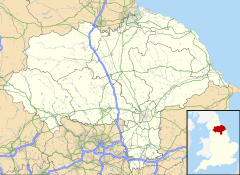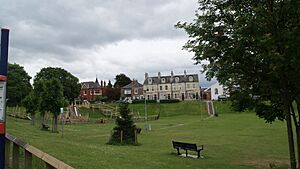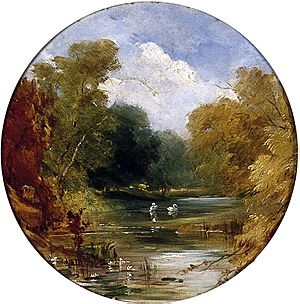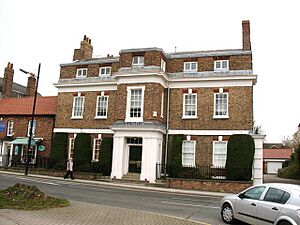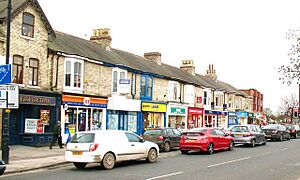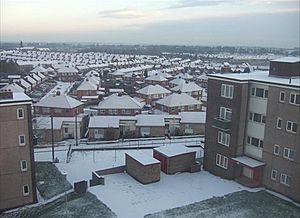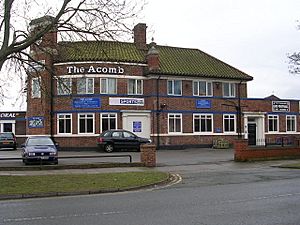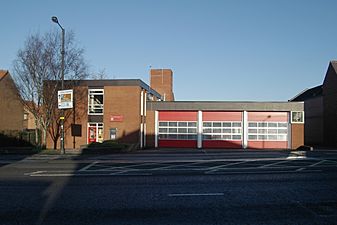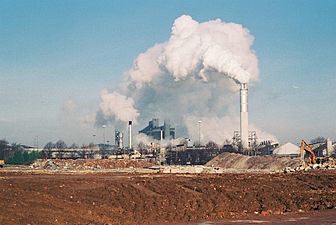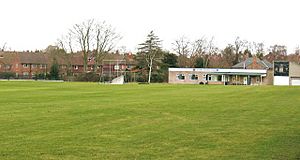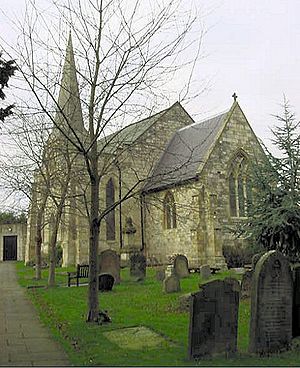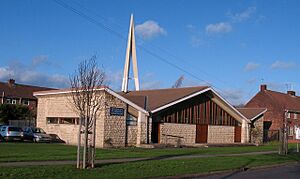Acomb, North Yorkshire facts for kids
Quick facts for kids Acomb |
|
|---|---|
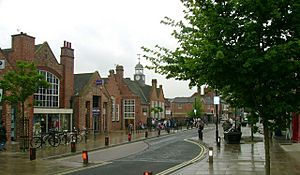 Shopping area on Front Street, Acomb |
|
| Population | 22,215 |
| OS grid reference | SE574513 |
| Unitary authority | |
| Ceremonial county | |
| Region | |
| Country | England |
| Sovereign state | United Kingdom |
| Post town | YORK |
| Postcode district | YO24, YO26 |
| Dialling code | 01904 |
| Police | North Yorkshire |
| Fire | North Yorkshire |
| Ambulance | Yorkshire |
| EU Parliament | Yorkshire and the Humber |
| UK Parliament |
|
Acomb is a village and suburb located in the City of York area in North Yorkshire, England. It sits on the western side of York. Acomb is mentioned in the famous Domesday Book from 1086, showing it has a long history. It is surrounded by other areas like Holgate, Clifton, and Woodthorpe. To the west, it borders fields near the A1237, which is the York Outer Ring Road.
Acomb used to be part of the West Riding of Yorkshire. It became part of the City of York in 1934.
Long ago, Acomb was a farming village. Over time, it grew into a place where many people lived who worked in big industries, like building trains, especially in the 1800s and 1900s. Today, it doesn't have large factories, but it has a busy shopping area. There are at least 19 buildings in Acomb that are listed as Grade II, meaning they are historically important. In 1975, the old part of Acomb, especially around Front Street and The Green, was made a special "conservation area" to protect its village feel. It's also an Area of Archaeological Importance, which means it's a place where old historical items might be found.
Acomb is divided into two parts, or wards, for the City of York: Acomb and Westfield. In 2011, Acomb had a population of 22,215 people, making it the largest area in the city. It has six primary schools and one comprehensive school. There are also many sports clubs and a public sports centre.
Acomb is known in York for having many street bollards (short posts). These were put in place in 2023 and have caused some debate among local residents because there are so many of them.
Contents
History of Acomb
What's in a Name?
Acomb existed even before the Norman Conquest in 1066. It's mentioned in the Domesday Book, which was a big survey of England ordered by William the Conqueror. Acomb was owned by the church leaders of York Minster. The name "Acomb" probably comes from an old English word, acum, which means 'at the oak trees'. This suggests the village was first built in an area with many oak trees. Over the years, the name was spelled in different ways, like Achum, Acum, Acome, and Akome. Once printing became common, the spelling became "Acomb" as we know it today. Some people used to pronounce it "Yackam".
Ancient Roman Times
Some historians believe that the Roman Emperor Septimius Severus was cremated (his body burned) in a military funeral near where Acomb is today. He died in York (which was called Eboracum back then) in 211 AD.
Early Village Life (10th and 11th Centuries)
During the time of Edward the Confessor, who was King before the Normans, Acomb was a manor. This means it was a large estate with a village, owned by a lord. The Domesday Book shows that most of Acomb's land belonged to the Archbishop of York. Land was measured in carucates, and Acomb had two carucates. The Domesday Book mentions Acomb several times, describing its land, people, and how much it was worth.
From the 12th to 16th Centuries
In the 12th century, St Stephen's Church was built. The original church stood until 1832, when a new, slightly bigger one was built. After the Norman Conquest, Acomb was a forested area and had special laws from the king about its woods. To get rid of these laws, the people of Acomb paid money to King Richard I and King John. Soon after King John's reign, the area was cleared of trees.
Between 1220 and 1538, the lord of Acomb manor was called the treasurer instead of the archbishop. This meant Acomb and its church were not under the bishop's control. The treasurer could hold court and handle important legal matters. This changed when Edward VI became king.
In the 1300s, Acomb was a typical Anglo-Saxon village with farms. During the time of Edward III, a local farmer named John de Acomb even contributed money to the king's military plans, which were funded by wool merchants.
Acomb Grange was once where the leaders of the medieval St Leonard's hospital lived. Later, in 1552, a Member of Parliament for York, George Gale, bought the Grange. His family continued to own land in the area for a long time, and Gale Lane is named after them. There are also two old 15th-century timber-framed houses in Acomb.
Growing Up (17th to 19th Centuries)
From 1623 to 1855, Acomb manor was again controlled by the archbishops. A survey in 1670 showed that Acomb had 41 households with 230 people. The population of Acomb grew steadily in the early 1800s. Many workers for the railway carriage factories in nearby Holgate, built around 1854, lived in Acomb, helping the village grow. By 1871, Acomb had less than 1,000 residents.
Acomb became its own local council area in 1894. In 1855, the manor was sold for a large sum of money. The last lord of Acomb ended his role in 1925. In 1937, Acomb became part of the City of York. At that time, the population was about 7,500, and by 1951, it had more than doubled to 16,235.
The York New Waterworks Company built its facilities at Acomb Landing in 1846 to supply water to York and nearby areas. This site still serves the area today. Gas came to Acomb in 1844, and electricity arrived in 1913.
The 20th Century
In 1920, the City of York bought Acomb Hall to create a maternity hospital. It opened in 1922 but later became a hospital for older people in 1954.
The Regent Cinema opened in Acomb on February 12, 1934. It had 899 seats. Like many cinemas, it faced challenges in the 1950s and closed on April 4, 1959. The last film shown was "Sierra Baron".
How Acomb is Governed
Acomb is part of the City of York local government area. It has two wards, Acomb Ward and Westfield Ward, which elect councillors to the city council. Acomb Ward elects two councillors, and Westfield Ward elects three. These councillors represent about 6.4% of all City of York councillors.
After the local elections in May 2023, the councillors for Acomb Ward are Katie Lomas and Jason Rose. The councillors for Westfield Ward are Andrew Waller, Jo Coles, and Emily Nelson.
In 1934, about 1223 acres (495 ha) of Acomb were moved into York parish. In 1937, the parish was officially ended, and the remaining 358 acres (145 ha) became part of Askham Bryan. In 1931, the parish had a population of 5,580.
People of Acomb (Demographics)
| Historical population | |||||||||||||||||||||||||||||||||||||||||||||||||||||
|---|---|---|---|---|---|---|---|---|---|---|---|---|---|---|---|---|---|---|---|---|---|---|---|---|---|---|---|---|---|---|---|---|---|---|---|---|---|---|---|---|---|---|---|---|---|---|---|---|---|---|---|---|---|
|
|
|
|||||||||||||||||||||||||||||||||||||||||||||||||||
| Data not available for 1951, 1961, 1971, 1981 and 1991 censuses. | |||||||||||||||||||||||||||||||||||||||||||||||||||||
Westfield Ward Population
In 2001, Westfield Ward had 13,690 people. Most (93%) were born in England. The largest age group was 30 to 44 years old. Most people (96.8%) were White-British. About 74% said they were Christian, and 16.8% said they had no religion. Many people (60%) were employed, and 15% were retired. Most homes were semi-detached (42.8%) or terraced (31.3%).
In 2011, the population of Westfield Ward slightly decreased to 13,611. About 59.2% were Christian, and 39.5% had no religion or didn't say. Most people (94.4%) were White/British.
Acomb Ward Population
In 2001, Acomb Ward had 7,729 people. Most (94.4%) were born in England. The largest age groups were 30-44 and 45-59 years old. Most people (97.9%) were White-British. About 80.2% were Christian, and 13.2% had no religion. Many people (66.7%) were employed, and 17% were retired. Most homes (75.5%) were semi-detached.
In 2011, the population of Acomb Ward increased to 8,604. About 65.6% were Christian, and 33.3% had no religion or didn't say. Most people (95.5%) were White/British.
Geography of Acomb
Acomb has several open green spaces. Bachelor Hill is the highest point in Acomb, about 90 feet above sea level. It's a sandy hill with grass and some trees. Fishponds Wood is a mix of trees and shrubs where an old pond used to be. The biggest open space is Acomb Wood.
In 2007, the City of York Council made Acomb Wood and Meadow a special local nature reserve. This area is home to many birds, like the great spotted woodpecker and tawny owls. You can also find different trees like ash and sycamore. The Old Hay Meadow in the East Wood has butterflies like the small skipper and common blue.
Two main roads go through Acomb: the A59 (York to Liverpool road), called Boroughbridge Road, and the B1224 (York to Wetherby road), which has different names like Wetherby Road and Acomb Road. The centre of Acomb is about two and a quarter miles from the centre of York. Acomb also includes smaller areas like Westfield, Low Field, Chapelfields, and Carr Hill.
The Conservation Area in Acomb protects Acomb Green and the old buildings around it. It also includes parts of Wetherby Road and Front Street, covering about 14.5 hectares (about 36 acres).
Economy of Acomb
Until the early 1900s, Acomb's main business was farming. There were several farms, like Gale Farm. But as more people moved from York, farming declined, and all the farms were gone by the end of the century.

Acomb now has a shopping area mainly around Front Street and Acomb Road. You can find local food shops, well-known brands, banks, and professional services like dentists.
There are also pubs, cafes, small restaurants, and take-away food places. In 2006, a large British Sugar factory near Boroughbridge Road closed, which meant 100 jobs were lost and caused problems for local farmers.
Homes in Acomb are a mix of council estates (built by the local council) and privately owned houses. Smaller shopping areas with a few stores are often found in the middle of these housing estates. You can see examples on Beckfield Lane, Cornlands Road, Gale Lane, and Foxwood Lane. Pubs like the King William and the Beagle are also found near these local shops.
Education in Acomb
After Grammar Schools were stopped in York in 1985, Acomb had three comprehensive schools: Oaklands Secondary School, Lowfields School, and Manor Church of England School. In 2007, Oaklands and Lowfield combined to form York High School. A new building was built on the old Oaklands site. In 2009, Manor Church of England School moved out of Acomb to a new location. York High School does not have a sixth form, so students who want to study for 'A' levels usually go to York College. The school has a nursery, a sports hall, and a swimming pool. It also has community allotments that were shown on BBC Gardeners' World.
Acomb has four Primary Schools:
- Carr Junior on Ostman Road, opened in 1948.
- Hob Moor Primary on Green Lane, opened in 1954. In 2007, it moved into a new building with Hob Moor Oaks Special School.
- Our Lady Queen of Martyrs Roman Catholic Primary, which moved to Holgate in 2011 after combining with another school.
- Westfield Primary Community on Askham Lane, opened in 1951.
The former Acomb Primary School, which was one of the oldest in North Yorkshire, has since moved to Holgate.
Sports in Acomb
Before the York Racecourse was built, Acomb Moor was used for horse racing. Acomb Moor was located south of Westfield, where the Woodthorpe and Acomb Park housing estates are now. Acomb also gives its name to The Acomb Stakes, a horse race held at the Knavesmire every August.
Acomb FC was one of the first teams in the York Football League in 1897 and the Yorkshire Football League in 1920. Today, Acomb has one football club called Moor Lane, which plays its home games at York High School.
Behind The Green is Acomb Sports & Social Club, home to Acomb Cricket Club and Acomb Hockey Club. York Acorn Rugby League Club plays its home games at Thanet Road in Acomb.
The City of York Council provides swimming facilities at the Energise project, which used to be Oaklands Sport Centre, next to York High School.
Religion in Acomb
The main church for Acomb is St Stephen's Church. It's a Grade II listed building, built in 1831–1832 on the site of an older church. In 1992, a fire badly damaged St Stephen's, but it was repaired with help from the local community. It is now part of a parish with St Aidan's Church on Ridgeway, which was built in 1968.
The Roman Catholic Our Lady's Church, Acomb, on Cornlands Road, opened in 1955. Before that, services were held in Acomb Council School starting in 1941.
The Quakers (part of the Religious Society of Friends) first met in Acomb around 1906. In 1911, they bought the old Primitive Methodist Chapel on The Green, where they still meet today.
A temporary Methodist Chapel was set up in Lidgett Grove in Acomb in 1934, thanks to Sir Robert Newbald Kay. A permanent building was finished in 1937.
Acomb Methodist Church is on Front Street and was built in 1964. There is also the Anglican Holy Redeemer Church on Boroughbridge Road, the Baptist Church on Ridgeway, and Gateway Church, York (part of the Newfrontiers group of churches) in the Old School on Front Street.
Famous People from Acomb
The well-known 18th-century painter and engraver, Thomas Stothard, spent some of his childhood in Acomb. He stayed with his uncle and was taught by a local widow named Mrs Stainburn. He even drew her in one of his illustrations.
Sir Charles Burdet, a Baronet, lived in Acomb in 1777.
The English romantic poet, Charlotte Richardson (born Smith), lived most of her life in Acomb. She wrote poems, mainly about home life and religion, and they were published in magazines and books. She was born in York in 1775 and died at her Acomb home in 1825.
Award-winning novelist, Justin Hill, grew up in Acomb. His father, Reg Hill, was the headmaster at Our Lady's Roman Catholic School from 1976 to 1995.
|


